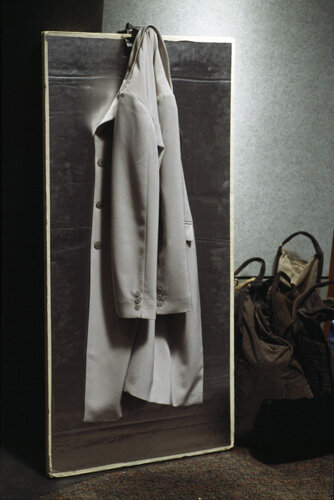Part of group show Come Into the Open, 0047, Oslo (NO), 2007
in Chapter "Photographic staging and reconstruction" by Marie Fraser in Replaying Narrative, Publication of Mois de la Photo à Montréal 2007
in Chapter "Photographic staging and reconstruction" by Marie Fraser in Replaying Narrative, Publication of Mois de la Photo à Montréal 2007
" Les oeuvres d'Ève K. Tremblay utilisent cette fixité ontologique de la temporalité photographique pour mettre en scène des instants narratifs où les actions sont maintenues dans un état perpétuel de suspension. Le moment où l'action va se produire est toujours retardé. L'expérience ne se concrétise pas, elle ne s'accomplit pas. La mise en scène ne sert donc pas à construire une unité mais à montrer que cette opération de suspension contient un potentiel d'anticipation. Plusieurs images d'Ève K. Tremblay explorent cette suspension en travaillant l'ambiguité entre la réalité et la fiction que peut produire une action lorsqu'elle est mise en scène par ses propres protagonistes. Dans la série d'images de lieux de tournage qui composent Unmanifested Still Films, cette spécifité temporelle de la photographie est soulignée par l'impossibilité de l'activité filmique de se manifester, de se déployer dans le temps. La photographie souligne sa spécificité et marque sa différence avec le cinéma, le terme still évoquant l'image arrêtée d'un mouvement."
extrait du texte Mise en scène et reconstitution photographiques de Marie Fraser dans Explorations Narratives, Publication du Mois de la Photo à Montréal 2007, (p.180) ( artists included: Elja-Liisa Ahtila, Gustavo Artigas, Eric Beaudelaire, Rebecca Belmore, Candice Breitz, David Claerbout, Stan Douglas, Patrice Duhamel, Douglas Gordon, Adad Hannah, Bettina Hoffmann, Mike Hoolboom, Teresa Hubbard & Alexander Birchler, Jesper Just, Karin Kihlberg & Reuben Henri, Thomas Kneubühler, Emmanuel Leonard, Cristelle Lheureux, Norton Maza, Valérie Mréjen, Saskia Olde Wolbers, Josée Pedneault, Paulette Philips, Marisa Portolese, Kelly Richardson, Elina Saloranta, Carlos & Jason Sanchez, Zined Sedira, Trine Sondergaard & Nicolai Howalt, Eve Sussman & The Rufus Corporation, Ron Terada, Althea Thauberger, Ève K. Tremblay, Salla Tykka, Chih-Chien Wang, Myriam Yates, Shad Yinong & Muchen.)
“The works of Ève K. Tremblay use the ontological fixity of photographic temporalityto stage narrative moments in which actions are kept in a perpetual state of suspension. The action’s occurrence is always delayed; the experience never materializes, is never completed. Staging, then, does not serve to build unity of action, but to show the potential for anticipation in suspension, which many of Tremblay’s images explore by developing the ambiguity between reality and the fictionthan can be produced when an action is staged by its own protagonists. In her serie of film-set images, Unmanifested Still Films, the temporal specificity of the photograph is underscored by the fact the activity of filming cannot become manifest, or unfold over time Photography marks its specificity and its difference frm cinema through the “ still,” the term conjuring a movement’s arrested image. “
from text Photographic staging and reconstruction by Marie Fraser in Replaying Narrative, Publication of Mois de la Photo à Montréal 2007, (p.180) ( artists included: Elja-Liisa Ahtila, Gustavo Artigas, Eric Beaudelaire, Rebecca Belmore, Candice Breitz, David Claerbout, Stan Douglas, Patrice Duhamel, Douglas Gordon, Adad Hannah, Bettina Hoffmann, Mike Hoolboom, Teresa Hubbard & Alexander Birchler, Jesper Just, Karin Kihlberg & Reuben Henri, Thomas Kneubühler, Emmanuel Leonard, Cristelle Lheureux, Norton Maza, Valérie Mréjen, Saskia Olde Wolbers, Josée Pedneault, Paulette Philips, Marisa Portolese, Kelly Richardson, Elina Saloranta, Carlos & Jason Sanchez, Zined Sedira, Trine Sondergaard & Nicolai Howalt, Eve Sussman & The Rufus Corporation, Ron Terada, Althea Thauberger, Ève K. Tremblay, Salla Tykka, Chih-Chien Wang, Myriam Yates, Shad Yinong & Muchen.)











